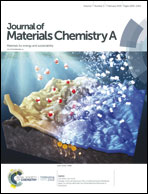High-performance lithium–organic batteries by achieving 16 lithium storage in poly(imine-anthraquinone)†
Abstract
Organic materials have attracted intensive research interest in lithium ion batteries (LIBs) due to their advantages of structural diversity, low cost and sustainability in nature. Here we report a highly conjugated organic framework, poly(imine-anthraquinone) (PIAQ), as the anode material of LIBs. It was synthesized by a green and environmentally friendly in situ solvothermal condensation reaction. When applied in LIBs, the PIAQ exhibits an outstanding reversible specific capacity (1231 mA h g−1 at 200 mA g−1), excellent long-term cycle stability (486 mA h g−1, 1000 cycles at 1 A g−1), and good rate performance. As further revealed by density functional theory (DFT) calculations, the Li storage mechanism of PIAQ is a reversible process associated with a six-step insertion/deintercalation of 16 Li+ per molecule, which is well consistent with the experimental results. Both the structural stability and excellent performance of PIAQ make it one of the most promising organic electrode materials for next-generation LIBs.



 Please wait while we load your content...
Please wait while we load your content...